Introduction
In Part – 1, I introduced the drone industry to the groundbreaking research of Professors Fernando F. Suarez, Stine Grodal, and Aleksios Gotsopoulos. Anyone entering an emerging industry—whether you're a startup founder, corporate innovator, or part of a VC or CVC team—take the time to understand this research. It provides a strategic advantage in navigating early industry dynamics.
In Part – 2, I presented a novel theory: the drone industry isn’t just following a path similar to the personal computer (PC) industry—it’s mirroring it. This parallel offers us more than historical context; it gives the drone industry a rare window into its own future.
My Motivation for this Article
Shortly after publishing Part – 2, I had the opportunity to speak on a keynote panel at the 2024 Commercial UAV Expo, titled Accelerating Commercial Viability and Market Demand. It gave me the chance to share some of my research, and while the feedback was overwhelmingly positive, I’m pretty sure many industry veterans were eyeing me like I was trying to sell them aluminum siding :)
My motivation for writing Part 3 is straightforward. In a recent Commercial UAV News article, respected industry thought leader Juan Plaza referenced my research and posed a simple but important question: “Is the FAA the right federal agency to regulate uncrewed aviation?”1 That question pushed me to take a deeper look at the ideas I had presented—and to reflect on the broader implications of the theory itself. My goal with this article is to spark constructive dialogue across the industry about how a new regulatory approach could evolve to better support emerging technologies like drones.
I fully acknowledge that some of the ideas presented here may be considered unconventional —or even radical. Then again, maybe they’re exactly what this moment calls for.
Seeing the Drone Industry Through a Different Lens
I came into the drone industry with no background in aviation. My entire career has been in the tech sector, so stepping into this world meant a steep learning curve. My very first job out of school was with IBM, at a time when the PC standard was still evolving. I watched, firsthand, how hardware, software, and services converged to create entirely new industries.
As I began attending educational sessions at drone industry events, something kept catching my attention. FAA regulators would say things like, “We feel like we’re regulating a technology.” I heard it enough times that it didn’t feel like a passing comment—it didn’t feel offhand. It felt important.
What struck me was that many with traditional aviation backgrounds seemed to dismiss these remarks as background noise. But to me, they weren’t noise, they were the signal. A signal that the drone industry wasn’t just bending the rules of aviation—it was quietly redefining them.
So, I began my research.
The more I researched, the more commonalities I found with the PC industry. Like the PC industry in its early days, the drone industry lacks standardization. It’s fragmented. It’s driven by startups and innovators trying to define the future. Like the PC before the internet, drones today lack a unifying infrastructure — the “digital highways” necessary to scale. We’re not just building machines; we’re laying the groundwork for an entirely new way of interacting with the physical world.
To me, drones are not simply aircraft — they’re flying computers. And if you accept that premise, then we shouldn’t be surprised that the same dynamics that shaped the PC industry are now shaping the drone ecosystem.
It’s like putting on a pair of reading glasses—one lens sees drones as aviation; the other sees them as technology. And when you look through both lenses at once, you don’t just see more clearly—you glimpse a world that wasn’t visible before, as if the future has quietly revealed itself.
The Drone Industry is Distinctly Unique
As shown in Figure – 1, when I analyze the electric car industry, it largely behaves the way you’d expect a new category to function within the broader automotive sector. While there are clear differences, the disruption is in the powertrain, fueling infrastructure, and some adjacent software layers—but they still behave like a category in the traditional automotive industry. Tesla didn’t invent a new kind of mobility; it redefined how a car is powered and built.
Now, contrast that with drones. This isn’t just a different story—it’s a different revolution. The drone industry doesn’t vaguely resemble the personal computer industry—it is following the exact same blueprint. From modular hardware and software-driven innovation to fragmented early markets and rapid iteration, the parallels aren’t coincidental—they’re undeniable. And that changes everything.

Drones might technically be “aircraft,” but functionally and economically they behave more like computers that happen to fly. Just like the PC revolution:
- The evolution of drones from larger aircraft parallels the evolution of PCs from mainframes. The first drones were large, complex machines primarily used for military purposes. Just as PCs revolutionized computing by making it affordable and accessible to everyone, drones have lowered the barriers to entry for aerial activities.
- The role of hobbyists in the early development and popularization of both the PC and drone industries has been pivotal, with enthusiasts driving innovation, creating communities/clubs/local events, and pushing the boundaries of what these technologies could achieve.
- Like the PC industry in its early years, the drone industry is composed of almost entirely emerging categories striving to become industries.
- The early PC industry saw a proliferation of companies building around the core platform—extending its capabilities with hardware, software, and services. That same pattern is now playing out in the drone industry today. A growing ecosystem of startups and innovators are rapidly expanding the utility of drones, creating a robust and competitive market that’s actively fueling the next wave of technological innovation.
- As the PC industry matured, numerous technologies that were once separate peripherals or add-on cards were embedded directly into the motherboard or became standard features of PCs. Like the PC, as the drone industry matures, various technologies that were once separate add-ons or external components are also being embedded directly into drones.
It is my opinion that drones are a new industry masquerading as a subsector. The drone industry is not a category of aviation; it's a parallel industry that just happens to operate in the air. It's its own ecosystem with its own economics, regulatory needs, infrastructure challenges, and innovation curves. That’s why treating drones like little airplanes has led to so much friction—aviation frameworks just aren’t designed for this kind of tech.
It’s not just a difference in form factor. It’s a difference in paradigm.
Regulatory Misalignment
The FAA has arguably the best safety record of any major regulatory agency. But now it’s tasked to absorb a category where failures are common, the players are smaller and underfunded, and the pace of change is exponential. This will erode the very credibility the FAA has spent decades building, not out of negligence, but because the nature of the drone industry is fundamentally incompatible with legacy processes.
The Lifespan & Pace Problem
The crux of the issue is that a 737 has a 30+ year life, so certifying it for the next few decades makes sense. A drone’s useful lifespan might be 3–5 years, and it’s likely to receive software updates every few weeks to months. The drone industry is made up of many lean, venture-backed companies that simply don’t have the resources to spend $20 million and 5 years on certification. The FAA’s model, while built for long-cycle safety and reliability, inadvertently creates barriers to entry, stifling the very innovation it’s trying to shepherd.
And while the consequences of drone accidents are typically minor compared to crewed aircraft, we can’t ignore the fact that a drone colliding with a commercial airliner could have catastrophic consequences. The risk is low—but not zero—and that’s why airspace safety coordination remains critical, even as the certification approach must evolve.
What’s needed is a regulatory model that can move at the speed of software—agile, modular, and iterative. The FAA, for all its strengths, simply wasn’t built for that pace. See Figure – 2.
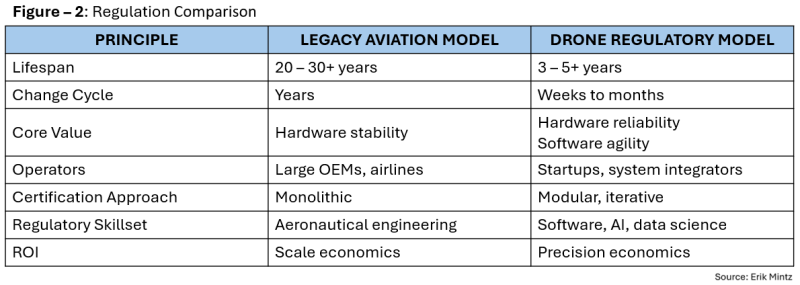
A Technology-Led Regulatory Approach
Regulating drones like airplanes is like pounding a ball of clay through a keyhole — it’s a force fit. To regulate it effectively, we must move beyond legacy frameworks and build a new regulatory home grounded in technological fluency, speed, and flexibility. What I’m recommending isn’t just regulatory reform. It’s institutional evolution—and it’s grounded in a deep understanding of how disruptive technologies behave.
In many ways, the FAA’s BVLOS ARC was a step in the right direction—it acknowledged the need for a more tailored, technology-aware regulatory approach. But what I’m proposing goes one step further. It’s not just about updating rules within the current system. It’s about creating a new kind of system entirely—one built to govern the drone economy at the speed of software and the scale of global innovation.
Establish a dedicated regulatory body for the drone industry within the Department of Transportation (DOT), with the following characteristics:
- Formed from the FAA’s current UAS Integration Office, preserving institutional knowledge while expanding its mandate and capabilities.
- Operates independently from the FAA’s legacy aviation framework but maintains close coordination and regular interface with the FAA to ensure safe integration into shared airspace.
- Staffed with technologists, software engineers, systems architects, safety analysts, and futurists, bringing the necessary expertise to regulate digital, modular flight systems and to anticipate how these technologies will evolve.
- Develops regulatory models that support modularity, rapid iteration, and continuous software updates, aligning with the operational realities of the drone industry.
- Leverages sandbox environments, pilot programs, and real-time operational feedback loops to create agile, responsive policy frameworks.
- Focuses on interoperability, infrastructure development, and global standardization, positioning the United States (U.S.) as a leader in drone governance.
The benefits of this approach include:
- Preserves FAA’s integrity by separating high-certitude aviation from dynamic drone tech.
- Accelerates innovation and integration of drones into the NAS.
- Positions the U.S. as a global leader in drone regulation and industry development.
- Improves compliance by creating rules that are realistic for the scale and speed of the drone industry.
Maybe give this new regulatory body a name that will encapsulate future innovations, something catchy like: AURA – Authority for Uncrewed Regulatory Advancement
Conclusion
The drone industry is not simply an extension of aviation—it is the aviation equivalent of the PC revolution. If my hypothesis is correct—and the evidence shows that it is—then drones are, at their core, computers that fly, and the industry is evolving in the same pattern we saw with the PC. This also matches the recurring sentiment from FAA regulators who’ve said, “We feel like we’re regulating a technology.”
The PC reshaped industries, empowered individuals, and redefined global power structures. The drone economy has the potential to be even more disruptive—bridging the physical and digital worlds while transforming how we move people and goods, respond to crises, grow food, and build infrastructure. As Jon Damush, CEO of uAvionix, once said to me: ‘drones are a way of democratizing flight’2—and that democratization doesn’t just expand access to the skies, it reshapes who gets to participate in the economy. Powered by AI, this transformation will accelerate automation, precision, and reach—amplifying the impact across every sector it touches.
So why doesn’t everyone see it yet? The answer is infrastructure. Just like in the early days of the personal computer—before the internet connected everything—its true potential wasn’t fully understood. The drone industry is now in a similar place, waiting for its own ‘internet moment.’2 The convergence of the physical, digital, and regulatory infrastructure that makes scaled operations possible. Without that foundation, the transformative potential of drones remains hidden in plain sight.
This is why a technology-led regulatory approach isn’t just necessary—it’s a strategic imperative. By acting decisively, the U.S. can shape not only the rules of engagement, but the rules of innovation. We have a unique opportunity to lead in drone manufacturing, operations, and in defining the global regulatory framework for this next-generation economy. And in a time when American manufacturing is a national priority, this is the industry to lead.
This approach would position the U.S. at the forefront of one of the most consequential technological shifts of our time and anchors our role in the next great industrial revolution.
REFERENCES
1. Juan Plaza, Commercial UAV News, Is the FAA the Right Federal Agency to Regulate Uncrewed Aviation, October 18, 2024
2. Erik Mintz, Commercial UAV News, Decoding the Drone Industry Part – 2: Echoes of the PC Revolution, August 14, 2024





.jpeg.small.400x400.jpg)


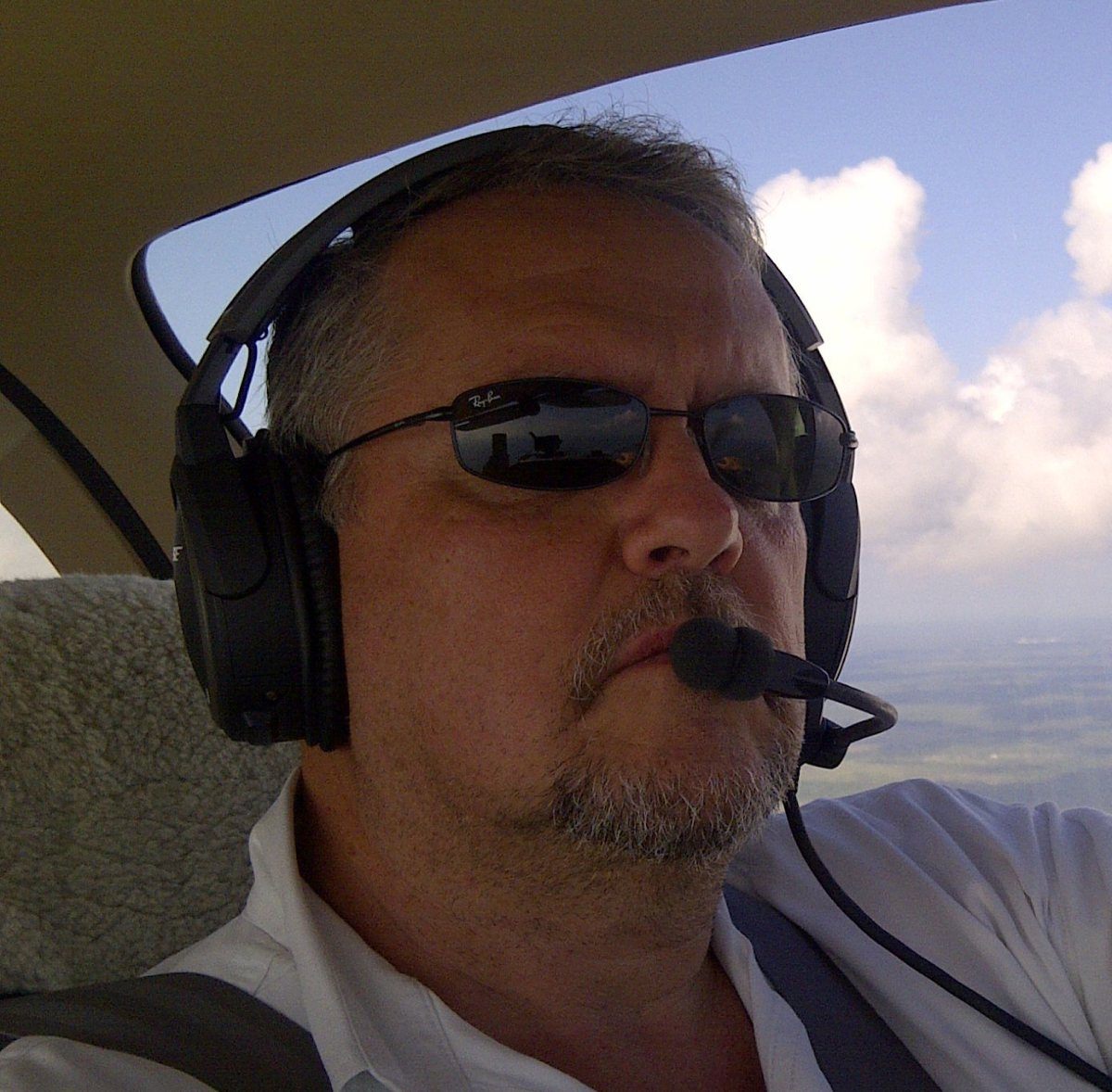




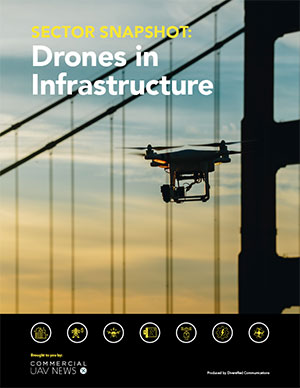
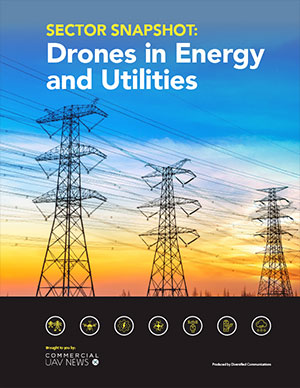
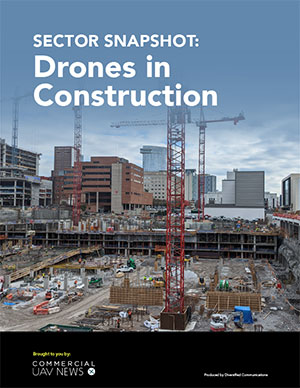
Comments